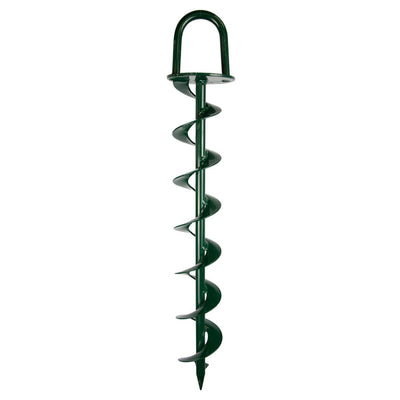Understand Why Ground Anchor Is Essential for Safety and Sturdiness
Ground supports are a vital component in construction, providing important support and stability for different frameworks. Comprehending the various kinds and applications of ground anchors can illuminate their essential function in ensuring safety and security and longevity.
Role of Ground Anchors in Building And Construction
Ground anchors play a crucial role in construction by giving important assistance and security to structures. These tools are created to transfer tons from a framework to the ground, guaranteeing that buildings and other facilities remain protected under various conditions. Ground anchors are specifically vital in circumstances where soil conditions are unsteady or where there is a risk of lateral activity, such as on inclines or near bodies of water.
The setup of ground supports includes drilling right into the planet to get to secure dirt or bedrock, where the supports can be firmly secured. This procedure not only improves the architectural integrity of a task but additionally alleviates the dangers related to soil erosion and changing. In addition, ground anchors can be used in short-lived frameworks, such as construction sites, where they supply required stabilization throughout the building procedure.
Ground anchors also add to the long life and toughness of frameworks by minimizing the likelihood of settlement and failing. Ground Anchor. By efficiently distributing and managing lots, these necessary elements are critical in preserving security standards and making sure the integrity of numerous construction projects. Generally, the significance of ground anchors in building and construction can not be overstated, as they are integral to successful engineering methods
Kinds Of Ground Supports


While various kinds of ground anchors exist, each offers specific applications and problems within construction jobs. One of the most common kinds include mechanical supports, grouted supports, and driven supports.
Mechanical supports, such as development anchors, utilize a mechanical action to protect the anchor within the substratum - Ground Anchor. These are frequently employed in lightweight applications, like safeguarding fixtures to masonry or concrete
Grouted supports, on the other hand, involve drilling a hole, placing a steel rod or cable television, and after that filling the annular space with cement. This technique is ideal for high-load scenarios, supplying boosted security and resistance to dynamic pressures commonly located in hefty building and construction.
Driven supports are normally mounted by driving a steel pole or pipeline into the ground, making them ideal for short-term applications such as protecting scaffolding or formwork. They fast to mount and can be gotten rid of easily when no more needed.
Various other customized anchoring systems include helical anchors, which are screw-like devices used in various soil conditions, and deadman anchors, which count on the weight of a buried challenge supply stability. Each type of ground anchor is developed to fulfill specific engineering demands, ensuring safety and security and architectural integrity.
Advantages of Utilizing Ground Anchors
The benefits of making use of ground supports in building jobs are substantial, boosting both security and architectural performance. Ground anchors give essential resistance against side forces, such as dirt motion, wind lots, and seismic activity. This resistance aids preserve the security of frameworks, protecting against prospective failings that might bring about expensive repairs or hazardous scenarios.
Furthermore, ground anchors help with the reliable transfer of loads from structures to the bordering dirt, guaranteeing a balanced circulation of weight. This load transfer lowers the threat of changing or clearing up, which can endanger the stability of a building in time. By employing ground anchors, designers can also create much more index reliable designs, as they enable slimmer architectural components while preserving safety standards.
In addition, ground supports are versatile and versatile to different soil conditions and project needs. Their setup can often be completed rapidly and with marginal disruption to the surrounding atmosphere, making them an effective option for several construction applications. Ultimately, making use of ground anchors improves not just the longevity of frameworks yet also adds to a more secure working atmosphere for construction workers and future residents.
Usual Applications and Utilizes
Countless construction jobs take advantage of ground supports for their efficiency in enhancing security and safety. These flexible components are typically utilized in different applications throughout the building and civil design markets. One widespread application is in retaining wall surfaces, where ground anchors offer the necessary assistance to stop dirt activity and maintain architectural stability.
In addition, ground anchors are crucial in protecting momentary structures, such as scaffolding and shoring systems, guaranteeing they continue to be steady during building and construction tasks. In the realm of foundation assistance, they are utilized to enhance existing frameworks, specifically in locations vulnerable to ground settlement or shifting dirt problems.
Ground anchors likewise locate substantial usage in incline stablizing projects, where they aid alleviate landslide threats by anchoring the soil to stable rock formations. An additional significant application is in the setup of wind generators, where they secure the base against lateral forces produced by wind, making sure functional safety and durability.
Moreover, ground supports are utilized in tunneling jobs to support the surrounding ground throughout excavation. Their varied applications underline the vital function ground anchors play in maintaining safety and resilience in various construction circumstances.
Setup Best Practices
Successful application of ground supports in various construction tasks rests on effective installation techniques. Proper installment is essential to ensure the supports accomplish their designated purpose and maintain architectural honesty gradually. Key finest methods include comprehensive site assessment, which entails reviewing dirt problems, lots demands, and ecological factors that might influence anchor performance.
Before installation, it is necessary to pick the proper these details kind of ground support based on the specific application and soil attributes. Making use of premium products and adhering to producer requirements will certainly boost the support's longevity and efficiency. Throughout setup, make sure that the support is put at the right angle and depth, as these elements dramatically affect load-bearing capability.
Additionally, using appropriate equipment and methods is crucial, including boring or driving techniques tailored to the site conditions. After installment, performing load testing can confirm the support's performance and identify any prospective concerns early. Normal evaluations are also advised to keep track of the problem of the supports and surrounding dirt. By adhering to these setup ideal engineers, specialists and techniques can improve the safety and long life of structures reliant on ground supports.

Conclusion
In summary, ground anchors are vital components in building, significantly boosting security and durability. Their capacity to transfer lots properly mitigates dangers connected with unstable dirt and lateral movements. The varied kinds and benefits of ground anchors, combined with their comprehensive applications, highlight their relevance in both long-term and short-term frameworks. Complying with installment best methods makes certain ideal performance, consequently adding to the general honesty my response and durability of building jobs.
The installation of ground supports entails exploration into the planet to get to secure dirt or bedrock, where the supports can be securely anchored.The benefits of using ground anchors in building projects are significant, improving both safety and security and structural efficiency.Numerous construction projects leverage ground anchors for their efficiency in enhancing stability and security.Successful application of ground anchors in numerous construction jobs hinges on effective installation practices.In recap, ground supports are essential elements in construction, considerably boosting safety and security and toughness.